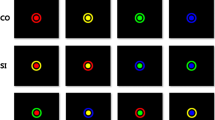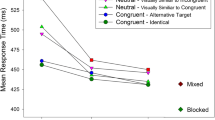Abstract
When participants were required to respond to a relevant central target and ignore irrelevant flanking stimuli, the flankers produced a response compatibility effect. Electrophysiological studies have shown that irrelevant flanker stimuli can affect the motor system. The present experiments further examined the characteristics of flanker effects on the motor system. Sixty participants responded in the flanker task to arrows (experiment 1) or letters (experiment 2). To examine time and extent of flanker effects on the motor system, target onset was delayed with blocked or random stimulus-onset asynchronies (SOA). With SOA of 0 and 100 ms, flanker effects on behavioral measures were reduced in random as compared to blocked conditions, but enhanced with SOA of 400 ms. With SOA of 400 ms, flanker effects on the early lateralized readiness potentials (LRP) were reduced in blocked as compared to random conditions, indicating that the onset of flanker effects on the LRP was delayed. Response-locked LRPs suggest that flanker and target stimuli activate the motor system successively. Findings challenge current theories of the flanker compatibility effect.











Similar content being viewed by others
Notes
For the sake of readability, SOA is positive despite the convention that positive SOA stands for conditions where the target occurred prior to the flankers.
Although a complete force–time function was measured on each trial, only those parameters are reported that are relevant to the current issue. Results do not depend on force threshold.
To get reliable behavioral results, for the estimation of behavioral effects, trials due to electrophysiological artifacts were not discarded.
Note that nonsignificant t-values mainly arise from a type II error, because experiment 2 showed the same pattern of results despite various procedural differences.
Note that the difference waveforms can become values below zero when the activity in compatible trials is larger than in incompatible trials. This is the case when the negative deflection returns to the baseline level. It is unclear whether these effects on the right side of the negative deflection are direct or indirect effects of flankers. Therefore, analysis of the difference waveforms were restricted to the positive flanker effects.
References
Band GP, Boxtel GJ van (1999) Inhibitory motor control in stop paradigms: review and reinterpretation of neural mechanisms. Acta Psychol 101:179–211
Berg P (1986) The residual after correcting event-related potentials for blink artifacts. Psychophysiology 23:354–364
Cohen A, Shoup RE (1993) Orientation asymmetry in the flanker task. Percept Psychophys 53:693–703
Coles MGH (1989) Modern mind-brain reading: psychophysiology physiology and cognition. Psychophysiology 26 251–269
Coles MGH, Gratton G, Bashore TR, Eriksen CW, Donchin E (1985) A psychophysiological investigation of the continuous-flow model of human information processing. J Exp Psychol Hum Percept Perform 11:529–553
Coles MGH, Gratton G, Donchin E (1988) Detecting early communication: using measures of movement-related potentials to illuminate human information processing. Biol Psychol 26:69–89
De Jong R, Liang CC, Lauber E (1994) Conditional and unconditional automaticity: a dual-process model of effects of spatial stimulus-response correspondence. J Exp Psychol Hum Percept Perform 20:731–750
Eimer M (1995) Stimulus-response compatibility and automatic response activation: evidence from psychophysiological studies. J Exp Psychol Hum Percept Perform 21:837–854
Eimer M, Schlaghecken F (1998) Effects of masked stimuli on motor activation: behavioral and electrophysiological evidence. J Exp Psychol Hum Percept Perform 24:1737–1747
Eriksen BA, Eriksen CW (1974) Effects of noise letters upon the identification of a target letter in a no-search task. Percept Psychophys 16:143–149
Eriksen CW, Schultz DW (1979) Information processing in visual search: a continuous flow conception and experimental results. Percept Psychophys 25:249–263
Eriksen CW, Coles MGH, Morris LR, O'Hara WP (1985) An electromyographic examination of response competition. Bull Psychon Soc 23:165–168
Flowers JH (1990) Priming effects in perceptual classification. Percept Psychophys 47:135–148
Flowers JH, Wilcox N (1982) The effect of flanking context on visual classification: the joint contribution of interactions at different processing levels. Percept Psychophys 32:581–591
Gehring WJ, Gratton G, Coles MGH, Donchin E (1992) Probability effects on stimulus evaluation and response processes. J Exp Psychol Hum Percept Perform 18:198–216
Gratton G, Coles MGH, Sirevaag EJ, Eriksen CW, Donchin E (1988) Pre- and poststimulus activation of response channels: a psychophysiological analysis. J Exp Psychol Hum Percept Perform 14:331–344
Gratton G, Coles MGH, Donchin E (1992) Optimizing the use of information: strategic control of activation of responses. J Exp Psychol Gen 121:480–506
Hommel B (1993) The relationship between stimulus processing and response selection in the Simon task: evidence for temporal overlap. Psychol Res 55:280–290
Jasper HH (1958) The ten-twenty electrode system of the International Federation. Electroencephalogr Clin Neurophysiol 10:371–375
Kopp B, Mattler U, Goertz R, Rist F (1996a) N2 P3 and the lateralized readiness potential in a no-go task involving selective response priming. Electroencephalogr Clin Neurophysiol 99:19–27
Kopp B, Rist F, Mattler U (1996b) N200 in the flanker task as a neurobehavioural tool for investigating executive control. Psychophysiology 33:282–294
Kornblum S, Hasbroucq T, Osman A (1990) Dimensional overlap: Cognitive basis for stimulus-response compatibility: a model and taxonomy. Psychol Rev 97:253–270
Kornblum S, Stevens, GT, Wipple A, Requin J (1999) The effects of irrelevant stimuli. 1. The time course of stimulus-stimulus and stimulus-response consistency effects with Stroop-like stimuli, Simon-like tasks, and their factorial combination. J Exp Psychol Hum Percept Perform 25:688–714
Miller JO (1988) Discrete and continuous models of human information processing: theoretical distinctions and empirical results. Acta Psychol 67:191–257
Miller JO (1991) The flanker compatibility effect as a function of visual angle attentional focus visual transients and perceptual load: a search for boundary conditions. Percept Psychophys 49:270–288
Miller JO, Hackley SA (1992) Electrophysiological evidence for temporal overlap among contingent mental processes. J Exp Psychol Gen 121:195–209
Mishkin M, Ungerleider LG, Macko KA (1983) Object vision and spatial vision: two cortical pathways? Trends Neurosci 6:414–417
Oldfield RC (1971) The assessment and analysis of handedness: the Edinburgh Inventory. Neuropsychologia 9:97–113
Osman A, Bashore TR, Coles MGH, Donchin E, Meyer DE (1992) On the transmission of partial information: inferences from movement-related brain potentials. J Exp Psychol Hum Percept Perform 18:217–232
Osman A, Moore CM, Ulrich R (1995) Bisecting RT with lateralized readiness potentials: precue effects after LRP onset. Acta Psychol 90:111–127
Ratcliff R (1979) Group reaction time distributions and analysis of distribution statistics. Psychol Bull 86:446–461
Ridderinkhof KR (2002) Activation and suppression in conflict tasks: empirical clarification through distributional analyses. In: Prinz W, Hommel B (eds) Common Mechanisms in Perception and Action. (Attention and performance, XIX) Oxford University Press, Oxford, pp 494–519
Ridderinkhof KR, Molen MW van der, Bashore TR (1995) Limits on the application of additive factors logic: violations of stage robustness suggest a dual-process architecture to explain flanker effects on target processing. Acta Psychol 90:29–48
Smid HGOM, Mulder G, Mulder LJM (1990) Selective response activation can begin before stimulus recognition is complete: a psychophysiological and error analysis of continuous flow. Acta Psychol 74:169–201
Stroop JR (1935) Studies of interference in serial verbal reactions. J Exp Psychol 18:643–662
Taylor DA (1977) Time course of context effects. J Exp Psychol Gen 106:404–426
Acknowledgements
Part of this work was described in the doctoral dissertation of the author at the University of Konstanz. A preliminary report of the data of experiment 1 was made at the 33rd Meeting of the Society for Psychophysiological Research, Rottach-Egern, Germany, October 1993. Data collection and first analysis were done at the Central Institute of Mental Health in Mannheim, Germany. The research was supported in part by a grant from the Deutsche Forschungsgemeinschaft (Ri 342/4). I am especially grateful to Jeff Miller for stimulating suggestions and helpful discussions. I thank Bruno Kopp, Richard Ridderinkhof, Fred Rist, Werner Sommer, Rolf Ulrich, and Dirk Vorberg for helpful suggestions, and Patrick Berg for letting me use his EEG data-analysis programs and for very helpful support.
Author information
Authors and Affiliations
Corresponding author
Rights and permissions
About this article
Cite this article
Mattler, U. Delayed flanker effects on lateralized readiness potentials. Exp Brain Res 151, 272–288 (2003). https://doi.org/10.1007/s00221-003-1486-5
Received:
Accepted:
Published:
Issue Date:
DOI: https://doi.org/10.1007/s00221-003-1486-5




